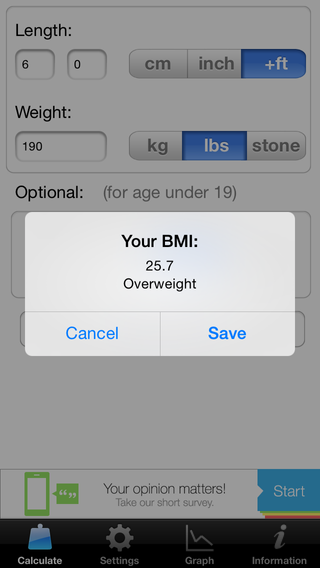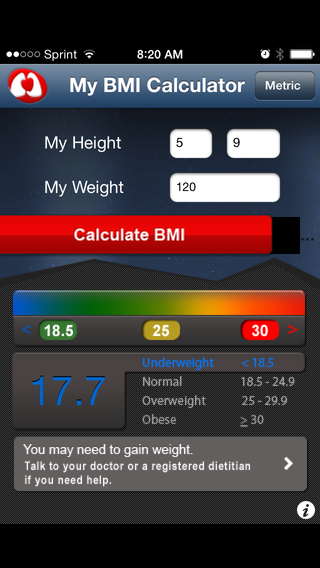Best BMI Calculator Apps

Body mass index, or BMI, is a way to estimate whether a person is at a healthy weight for his or her height. Although the measure isn't a perfect indicator of a person's overall health, it's an easy way for most people to determine whether they are underweight, normal weight, overweight or obese.
Many BMI-calculating smartphone apps make the process even easier — and let users keep track of changes to their BMI over time.
Before you launch any of those apps, though, here's a quick review of what BMI can and can't tell you about your health. The calculation, which dates back to the 1800s, is a mathematical formula that divides body mass by the square of height. (There are body mass index tables that make the calculation particularly easy.) The resulting number gives an estimate of body fat percentage.
BMI is only one factor to consider when assessing health, according to the National Heart, Lung and Blood Institute (NHLBI). Ideally, you'll also want to consider your waist circumference as well as any lifestyle or genetic risk factors for cardiovascular disease. And BMI can occasionally be misleading. According to the NHLBI, the measure often mistakenly classifies heavily muscled athletes as obese, and it can underestimate body fat in elderly or ill people who have lost muscle mass.
For most people, however, BMI is a useful measurement, offering at least a preliminary look at health. People with a BMI below 18.5 are considered underweight; normal weight falls between 18.5 and 24.9. A BMI of 25 to 29.9 is overweight, and 30 and above qualifies as obese.
The best apps offer both a BMI calculator and a way to record changes in your BMI over time. Our favorite is Fitter Fitness Calculator (Free, iOS).

Fitter rises to the top because it includes not only a BMI calculator, but also widgets to estimate your basal metabolic rate, body fat based on hip and forearm measurements, and waist-to-hip ratio. Taken together, these measurements offer a more holistic look at body composition than BMI alone can provide. Even better, the app includes information about each measurement and is honest about these measurements' limitations, such as the fact that BMI can be inaccurate in people who are very muscular.
Sign up for the Live Science daily newsletter now
Get the world’s most fascinating discoveries delivered straight to your inbox.
Fitter includes options for both metric and imperial units, and its simple, mostly black-and-white interface is easy to use. Under the Progress tab, users can find their current stats as well as graphs showing progress over time for each. This tracking feature is another distinguishing factor for Fitter, as many BMI apps are calculator-only.
Fitter also works as a simple weight tracker, allowing users to set weight-loss goals and reminders to weigh themselves.
The app's ads are generally unobtrusive, but for a $1.99 upgrade, Fitter users can get a version of the app without ads. This upgrade also enables data exporting, allows password protection and puts your weight-loss data right on the app icon.
Runner-up
If tracking your basal metabolic rate and waist-to-hip ratio seems like overkill, a great option is BMI Calculator by Data Supply (Free, iOS). This app is simply what it says it is: an easy-to-use BMI Calculator. You can enter your height in feet and inches, centimeters, or just inches; and your weight in kilograms, pounds or stones (a unit sometimes used in the U.K.), and the app does the rest.

A color-coded graph tracks BMI over time. Points in the green zone indicate normal weight, yellow indicates overweight and red indicates obesity. Fall below green into gray and you're underweight, according to the BMI tables.
The usual BMI categories are standardized for adult men and women of any age, but for children, the tables vary according to age. Conveniently, BMI Calculator has an optional section to include age for users younger than 19. Most apps can't handle adolescent or kid BMI calculations, but this one can.
BMI Calculator could be improved with the inclusion of a little more reference information. A pop-up informs users of their results and weight category, but gives little context as to what weight they would need to achieve to fall into a healthier category, or why the categories matter. (Of course, users already familiar with BMI and its implications may prefer this no-nonsense approach.)
BMI Calculator includes banner ads, but they're relatively subtle. The interface is clean, simple and uncluttered.
Other good apps

BMI calculators are relatively simple, so there are a lot of free ones to pick from. Among the bare-bones options, we liked CalculateBMI (free, iOS), an app with the weight of a federal institution behind it. Offered by the National Heart, Lung and Blood Institute, this app simply calculates adult BMI based on height and weight in either metric or imperial units. There is no tracking feature and no other bells and whistles, but the home screen conveniently lists the BMI scale and which numbers qualify someone as underweight, normal, overweight or obese. An information link takes you directly to the NHLBI page that explains the importance of a healthy weight — a very authoritative source on the topic.
Android users can turn to BMI Calculator - Weight Loss (Free, Android) for a simple app that calculates your BMI, waist-to-height ratio, approximate body-fat percentage and basal metabolic rate. Each calculation appears on a screen that offers a personalized ideal number for that measurement.
For 99 cents, myBMI (99 cents, iOS) is costlier than other calculators, but doesn't have the annoying ads. The app allows calculations in metric and imperial units, and lets you enter your height in inches, or in feet and inches. This app also includes more detail in its BMI scale, breaking down the "overweight" category into four classes. These classes are linked to the risk of health problems, and the app shows how more weight brings more health risks.
Another effective option is BMI Calculator% (Free, iOS, Android). Despite the odd punctuation, this app is heavily downloaded and well-reviewed, and for good reason. The calculator is stark and simple, with no frills at all. If you're looking for a plain BMI calculator, this is a good bet.
In the same vein, BMI Calculator for Women & Men (Free, iOS) is a simple, calculator-only app that won't hog storage space on your phone. There is no long-term tracking, nor does the app include other features beyond the calculator. But the app is easy to use, and the bottom-of-the-screen banner ads are unobtrusive.
Offbeat apps
BMI apps are generally geared toward people interested in losing weight — not those gaining it because they're pregnant, for example. But a handful of apps focus on helping pregnant women gain the appropriate amount of weight before their due date. One good choice is SureBaby (Free, iOS, Android), which uses your height and pre-pregnancy weight to calculate your BMI, and thus the appropriate amount of weight to gain during pregnancy. The app takes twin pregnancies into account as well as due date, to let users know whether they're on track for their particular point in gestation. Though simple, SureBaby is informative enough to include target weight ranges. The app also includes links to the SureBaby website, a pregnancy resource that includes week-by-week updates.
Follow Stephanie Pappas on Twitter and Google+. Follow us @livescience, Facebook & Google+. Original article on Live Science.

Stephanie Pappas is a contributing writer for Live Science, covering topics ranging from geoscience to archaeology to the human brain and behavior. She was previously a senior writer for Live Science but is now a freelancer based in Denver, Colorado, and regularly contributes to Scientific American and The Monitor, the monthly magazine of the American Psychological Association. Stephanie received a bachelor's degree in psychology from the University of South Carolina and a graduate certificate in science communication from the University of California, Santa Cruz.
Most Popular

